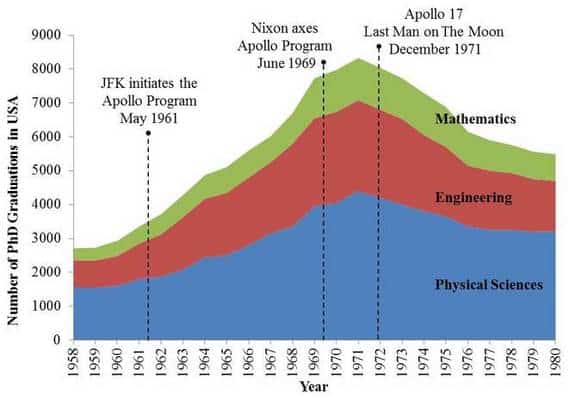In light of recent NASA budget cuts, a lot of politicians, citizens and, frankly mostly non-science folks, reflect that money should be funneled to other more, immediate goals: education, health, fighting unemployment etc. The rhetoric goes by the familiar terms that there isn’t any reason for man to venture outside the planet, until he at least settles his affairs in his own backyard. This is an example of projecting an individual perspective, however, onto a situation that concerns mankind as a whole – this sort of abstractions have always been difficult to touch by the lay man, who is inadvertently concerned with the well being of his own self, that of his family, all at present day or in the immediate future.
The space race of the past century, turned today in a space collaboration, has not only touched the hearts of millions and has inspired a world ever dominated by technology to actually get involved with science (the number of science students proportionately increased dramatically since the very first space missions, peaking during the Apollo era), but has also proved to be extremely economically sustainable. According to Ashley Dale, of University of Bristol, for every US$1 put into US space agency, its citizens get US$10 as payback; in Japan and the European Union that amount is more than US$3.
Where is this money coming from? Well, from the booming private space industry of course. Thanks to inventions spun out of space era research, today we’re all experiencing the benefits that come with weather forecasting, satellite television and communications, disaster relief, traffic management, agricultural and water management, and global positioning system (GPS). All of these just to name a few. Besides this, the space industry is what tens of thousands of employees all over the world call home; an industry that falls back into the economy some $300 billion each year.
The average annual expenditure of NASA during the Apollo Era was US$23 billion in today’s money, while NASA’s average spend in the last decade was US$17 billion. While the investments made then brought tremendous advancements in satellite communications and, of course, the infamous Apollo missions that eventually landed twelve astronauts on the moon, recent events at NASA have failed to deliver the same glory. Of course, the technological leap since the Apollo missions in the late ’60s and ’70s has been tremendous. We’ve since seen the completion of the International Space Station and the landing of three rovers on the planet Mars, the last of which, the Curiosity Rover, has already made startling discoveries on Mars: traces of organic matter, better atmospheric readings and geological surveys etc.
It’s just that, people – the general public – were guided to think that today we should have reached heights that are proportionally equal to the glory of the Apollo heyday – landing a man on Mars for instance, settling colonies on the moon. Personally, I believe there could have been a strong chance for this to happen if the same momentum, funding and spirit from the space race would have continued until present day. It’s enough to take a look at the graph from below to understand how people’s inspiration to seek for stars changes: a dramatic rise during Apollo, and a steady downward curve during the passive, more or less devoid of extremely significant events (for the general public), leading to this day.

Alright, so what’s next? Most likely we’ll see a paradigm shift, both in terms of power and scope. While NASA and ESA will still remain powerful players in the space scene for years to come, the Indian and Chinese programs are quick to follow and, if we’re to judge by their rapid industrialization and economic growth, may actually lead the way for man’s next big leaps among the stars. Hollywood is quick to show American astronauts touching base on Mars or maneuvering spacecraft through hyperspace. Movies aside, the astronauts of tomorrow will most likely be of much varied colours and allegiances.
Also, it may be safe to assume that the great impetus to achieve grand missions for mankind will be spearheaded by private corporations, and not by government programs, which in recent years have proven to be slow, rigid and prone to bureaucracy. Some believe it’s possible for humanity to establish a permanent manned base on Mars by 2100; the same people usually believe that such a move would not be about going higher than ever before, a chivalrous adventure for glory – it would be about survival. Reaching Mars by that time means providing humanity with a much needed second planet, one we could terraform (Mars hasa 24.6 hour day, fertile soil, a CO2 rich atmosphere, and an abundance of water). It’s worth remembering that we already use 1.5 Earths…
*update: the initial draft stated twenty-four astronauts landed on the moon; this has been duly corrected to twelve.






